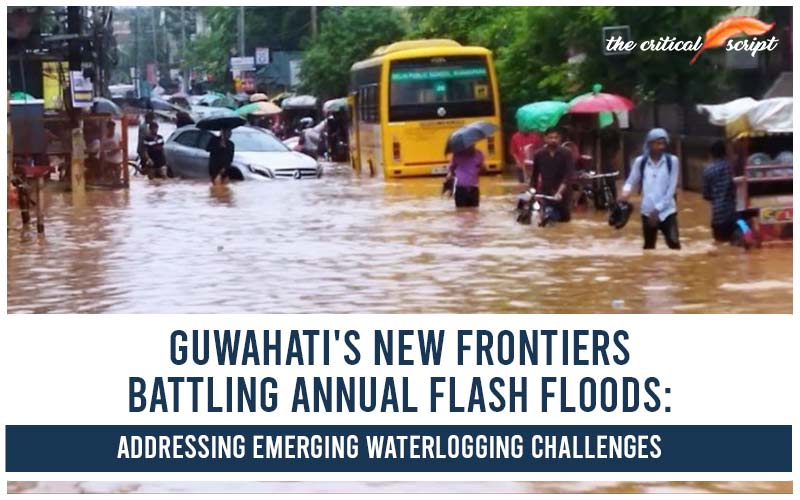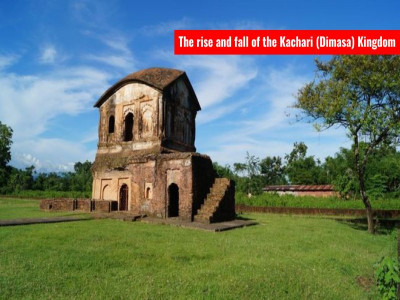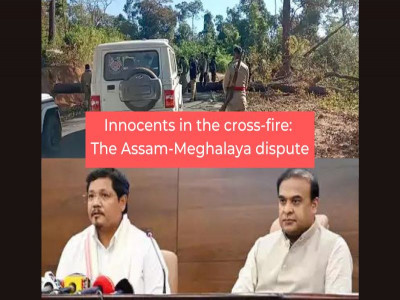
"Guwahati's New Frontiers Battling Annual Flash Floods: Addressing Emerging Waterlogging Challenges"
Guwahati, the vibrant capital city of Assam, is
plagued by persistent waterlogging, especially during the monsoon season. This
perennial issue disrupts daily life, damages property, and poses severe health
risks. Despite being a prominent urban center, Guwahati struggles with
infrastructural shortcomings, rapid and unplanned urbanization, and
underutilization of its natural rivers. Addressing these root causes and
implementing effective solutions are critical to alleviating this persistent
problem.
Affected Localities
Waterlogging affects numerous areas across
Guwahati, including:
Zoo Road: A vital commercial and
residential area often plagued by severe waterlogging, disrupting traffic and
local businesses.
Anil
Nagar and Nabin Nagar: These
densely populated neighbourhoods are notorious for chronic waterlogging,
severely affecting residents' mobility and daily activities.
GS Road: As a major arterial road, GS
Road frequently suffers from waterlogged sections, leading to significant
traffic congestion.
Chandmari: Known for its residential
complexes and educational institutions, Chandmari experiences regular
waterlogging, causing inconvenience to students and residents.
R.G.
Baruah Road: This
key thoroughfare often sees water accumulation, impacting both vehicular
movement and pedestrian safety.
In addition, every year, new areas are being added in Guwahati that experiences the brunt of flash floods and waterlogging, which are – Satgaon, Panjabari, Beltola, and Maligaon.
Inadequate Drainage System: Guwahati’s drainage infrastructure is outdated and insufficient,
unable to handle the heavy monsoon rains effectively.
Rapid Urbanization and Unplanned Construction: Unplanned and rapid urban development has led to the encroachment of
natural water bodies and drainage channels, significantly reducing the city's
capacity to manage rainwater.
Topographical Challenges: Guwahati’s hilly terrain contributes to rapid runoff into low-lying
areas, leading to waterlogging.
Clogged Drains: Poor
maintenance and blockages caused by garbage, silt, and debris exacerbate the
problem.
Lack of Government Initiatives: Despite repeated flooding, there has been a noticeable lack of
comprehensive and effective government action to address the root causes of
waterlogging. Delays in infrastructure projects, insufficient maintenance of
existing systems, and inadequate urban planning worsen the issue.
Underutilized Natural Rivers: The city's natural rivers, such as the Bharalu, Basistha, and Mora
Bharalu, could play a crucial role in managing rainwater and preventing
waterlogging but are not effectively utilized.
The Potential of Natural Rivers
Guwahati is crisscrossed by several natural rivers,
which, if properly managed, could significantly alleviate the waterlogging problem:
Bharalu River:
Flowing through the heart of Guwahati, the Bharalu River has the potential to
be a major drainage channel for the city. However, its current state of
neglect, with pollution and encroachment issues, limits its effectiveness.
Basistha River: This
river could serve as a natural drainage conduit, helping to channel excess
rainwater away from residential and commercial areas.
Mora Bharalu:
Another vital waterway, the Mora Bharalu, can play a significant role in
mitigating waterlogging if restored and maintained properly.
Impact on Residents
Health Risks:
Stagnant water serves as a breeding ground for mosquitoes, leading to diseases
such as dengue, malaria, and chikungunya. Waterlogging also increases the risk
of waterborne diseases.
Property Damage:
Constant waterlogging damages homes, businesses, and infrastructure, leading to
financial losses and expensive repairs.
Traffic Disruption:
Flooded streets cause severe traffic jams and accidents, making it difficult
for residents to commute and affecting emergency services.
Economic Impact:
Businesses suffer due to decreased customer footfall and disruptions in the
supply chain, leading to economic losses.
Daily Inconvenience:
Waterlogged roads and pathways make it challenging for people to move around,
affecting daily activities and quality of life.
Mitigation Measures
Comprehensive Government Initiatives: The government must prioritize and implement comprehensive flood
management plans. This includes upgrading and expanding drainage infrastructure,
enforcing urban planning regulations, and ensuring timely maintenance of
existing systems.
Regulated Urban Development: Implementing stringent regulations on urban development to prevent
encroachment on natural drainage channels and wetlands is crucial. Ensuring
that new constructions comply with environmental and planning standards will
help mitigate waterlogging.
Public Awareness Campaigns: Educating residents about the importance of not dumping garbage in
drains and encouraging community participation in keeping drains clean can
significantly reduce blockages.
Restoration Projects:
Initiating comprehensive restoration projects for the Bharalu, Basistha, and
Mora Bharalu rivers to clean and clear them of pollutants and encroachments.
Integrated Water Management: Developing an integrated water management plan that includes the
natural rivers as key components of the city's drainage infrastructure.
Rainwater Harvesting:
Promoting rainwater harvesting can help reduce the burden on drainage systems by
capturing and utilizing rainwater.
Regular Maintenance:
Establishing a regular maintenance schedule for rivers and drainage channels to
prevent blockages and ensure smooth water flow.
Emergency Response Plans: Developing a robust emergency response system to deal with
waterlogging, including quick evacuation plans and relief measures, can
mitigate the impact on residents.
Conclusion
The persistent waterlogging in Guwahati is a
complex issue that demands immediate and concerted efforts from both the government
and the community. Addressing this problem requires a multifaceted approach,
including upgrading infrastructure, promoting sustainable practices, restoring
natural rivers, and fostering community involvement. By implementing
comprehensive and sustainable solutions, Guwahati can overcome this perennial
challenge and ensure a better quality of life for its residents. This approach
not only promises a safer, more resilient future for the city but also
contributes to its overall growth and environmental health.
Disclaimer: The opinions expressed in this article are those of the author's. They do not purport to reflect the opinions or views of The Critical Script or its editor.

Newsletter!!!
Subscribe to our weekly Newsletter and stay tuned.

















Related Comments